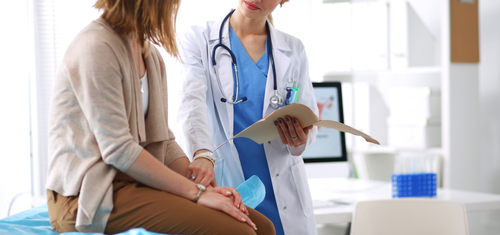
If you are a woman, chances are you will develop uterine fibroids at some point in your life. Fibroids, or growths that develop from the cells of the uterus, are extremely common, with as many as 80 percent of women presenting with them before the age of 50.
The obstetrics and gynecology team at Summit Health specializes in the diagnosis, evaluation, and treatment of uterine fibroids. The condition, which can cause pelvic pain and heavy bleeding, does not have to interfere with your quality of life. There are numerous treatment options from medication to surgical interventions that can help.
Our experts partner with patients to help them make the best possible decisions about how to manage their condition. Bernice Adu-Amankwa, MD, FACOG, an obstetrician and gynecologist at Summit Health explains what every woman should know about uterine fibroids.
1. Not all uterine fibroids are created equal.
Fibroids vary in size, location, and severity. Sometimes only one nodule grows, or several may appear together in a cluster. Small fibroids may be less than 1cm, about the size of a tiny seed, while large growths may reach several inches in diameter. When fibroids get too big, Dr. Adu-Amankwa explains, they may become uncomfortable and push on the stomach or bladder causing symptoms such as frequent urination or feeling full early.
2. Many women with uterine fibroids do not have any symptoms.
Depending on the location and size of the fibroid, a woman may or may not have any symptoms. Many patients have no symptoms at all while other patients may experience:
- Abnormal bleeding, including heavier than normal periods or bleeding between menstrual cycles
- Pelvic pain or pressure
- Frequent urination
- Distended abdomen
- Pain during or after intercourse
Often women do not know they have fibroids until they are discovered during a routine check-up. Your physician may be able to feel the nodule on a physical exam or it may be found on a pelvic ultrasound done for another reason.
3. Uterine fibroids are always benign.
“Many of my patients have concerns that their fibroid is, or could become, cancerous,” says Dr. Adu-Amankwa. “While fibroids are benign, there are rare tumors of the uterus which resemble fibroids that may be cancerous.” This is rare and is called a leiomyosarcoma. If you are diagnosed with a uterine tumor, it is important to discuss the characteristics that may indicate it is cancerous with your OBGYN.
4. The exact cause of fibroids is unknown.
“There is usually no rhyme or reason as to why certain women develop fibroids,” explains Dr. Adu-Amankwa, “but we do see some patterns.”
Studies show that Black women and women of Hispanic descent are more likely to develop fibroids than Caucasian women. There also appears to be a genetic predisposition, as fibroids tend to run in certain families. Age is also a factor; women in their 40s are more likely to be diagnosed with uterine fibroids than those who are 20 something.
5. Uterine fibroids are controlled by hormones.
The relationship between uterine fibroids and hormones must be monitored carefully. High levels of the hormones estrogen and progesterone can cause fibroids to grow. As a result, fibroids typically get smaller and are less problematic when a woman reaches menopause.
For women whose fibroids are causing heavy menstrual bleeding, using birth control may help. Your physician will help decide what course of action is right for you based on the size of your fibroid, its location, the symptoms you are experiencing, and if you plan to become pregnant in the future.
6. Women with uterine fibroids can have healthy pregnancies.
If you know you have fibroids and want to start a family, it is important to talk to your physician. Dr. Adu-Amankwa has helped many patients with fibroids come up with a plan so they can have a healthy pregnancy. In some cases, the fibroids will not cause any problems. But in other women, the fibroids can interfere with their ability to get pregnant or the growth of the baby. It is important to communicate openly with your doctor about your goals for family planning.
7. Some fibroids are best left alone.
If your fibroids are not bothering you, Dr. Adu-Amankwa usually advises a hands-off approach. These patients will continue to be monitored closely.
8. Numerous treatment options exist.
When patients have symptoms, Dr. Adu-Amankwa explains the range of options that are available. “Unless it is contraindicated, I always encourage patients to try medical therapies like birth control pills or an IUD first, before they turn to more definitive treatments such as surgery.”
If hormonal options fail or are not well tolerated there are numerous procedural options including:
- Uterine Fibroid Embolization (UFE) is a minimally invasive procedure where small particles are injected into the arteries to diminish the blood supply to the fibroids, causing them to shrink. This procedure is performed by an interventional radiologist. At Summit Health, UFE is conveniently and comfortably performed as an outpatient/same-day procedure within our Interventional Radiology suite located at 150 Park Avenue in Florham Park.
- Endometrial ablation is a procedure used to control heavy bleeding by burning away the thin layer of tissue that lines the uterus.
- Myomectomy is typically reserved for patients who want to preserve their fertility. Fibroids are surgically removed through an incision in the lower abdomen.
- Hysterectomy, a surgery to remove a woman’s uterus or womb, is the most definitive treatment for fibroids. Sometimes this surgery also incorporates removal of the ovaries and fallopian tubes.
9. You can’t prevent uterine fibroids.
Patients often ask Dr. Adu-Amankwa how they can avoid uterine fibroids from growing or reoccurring. Unfortunately, she says, there really is not a definitive answer. For overall good health, the physician recommends eating a nutritious diet, getting regular exercise, and reducing stress as much as possible.
